Probabilistic Analysis of Green Hydrogen Production from a Mix of Solar and Wind Energy
Abstract
:1. Introduction
2. Materials and Methods
3. Results
3.1. Characteristics of Energy Production by Photovoltaic Systems
3.2. Characteristics of Energy Production by Wind Turbines
3.3. Energy Production Characteristics of a Mix of Photovoltaic Systems and Wind Turbines
4. Discussion
5. Conclusions
Author Contributions
Funding
Data Availability Statement
Conflicts of Interest
Abbreviations
| RES | Renewable energy source |
| PEM | Proton exchange membrane |
| AEM | Aion exchange membrane |
| AFC | Alkaline fuel cell |
| SOFC | Solid oxide fuel cell |
| SOE | Solid oxide electrolyzer |
| MCFC | Molten carbonate fuel cell |
| FCV | Fuel cell vehicle |
| PV | Photovoltaic |
References
- Available online: https://www.rynekelektryczny.pl/moc-zainstalowana-fotowoltaiki-w-polsce/ (accessed on 1 August 2024).
- Available online: https://www.forum-energii.eu/rocznik-dane-o-energetyce (accessed on 1 August 2024).
- Gnap, J.; Šarkan, B.; Konečný, V.; Skrúcaný, T. The impact of road transport on the environment. In Ecology in Transport: Problems and Solutions; Springer: Cham, Switzerland, 2020; pp. 251–309. [Google Scholar]
- Raihan, A.; Pavel, M.I.; Muhtasim, D.A.; Farhana, S.; Faruk, O.; Paul, A. The role of renewable energy use, technological innovation, and forest cover toward green development: Evidence from Indonesia. Innov. Green Dev. 2023, 2, 100035. [Google Scholar] [CrossRef]
- Petkov, I.; Gabrielli, P. Power-to-hydrogen as seasonal energy storage: An uncertainty analysis for optimal design of low-carbon multi-energy systems. Appl. Energy 2020, 274, 115197. [Google Scholar] [CrossRef]
- Lin, Y.C.; Wyżga, P.; Macyk, J.; Macyk, W.; Guzik, M.N. Solar-driven (photo)electrochemical devices for green hydrogen production and storage: Working principles and design. J. Energy Storage 2024, 82, 110484. [Google Scholar] [CrossRef]
- Silalahi, D.F.; Blakers, A.; Cheng, C. 100% Renewable Electricity in Indonesia. Energies 2024, 17, 3. [Google Scholar] [CrossRef]
- Trattner, A.; Kleli, M.; Radner, F. Sustainable hydrogen society e Vision, findings and development of a hydrogen economy using the example of Austria. Int. J. Hydrogen Energy 2022, 47, 2059–2079. [Google Scholar] [CrossRef]
- Megía, P.J.; Vizcaíno, A.J.; Calles, J.A.; Carrero, A. Hydrogen Production Technologies: From Fossil Fuels toward Renewable Sources. A Mini Review. Energy Fuels 2021, 35, 20. [Google Scholar] [CrossRef]
- Le, T.T.; Sharma, P.; Bora, B.I.; Tran, V.D.; Truong, T.H.; Le, H.C.; Nguyen, P.Q.P. Fueling the future: A comprehensive review of hydrogen energy systems and their challenges. Int. J. Hydrogen Energy 2024, 54, 791–816. [Google Scholar] [CrossRef]
- Worku, A.K.; Ayele, D.W.; Deepak, D.B.; Gebreyohannes, A.Y.; Agegnehu, S.D.; Kolhe, M.L. Recent Advances and Challenges of Hydrogen Production Technologies via Renewable Energy Sources. Adv. Energy Sustain. Res. 2024, 5, 2300273. [Google Scholar] [CrossRef]
- Okunlola, A.; Davis, M.; Kumar, A. The development of an assessment framework to determine the technical hydrogen production potential from wind and solar energy. Renew. Sustain. Energy Rev. 2022, 166, 112610. [Google Scholar] [CrossRef]
- Agyekum, E.B.; Nutakor, C.; Agwa, A.M.; Kamel, S. A Critical Review of Renewable Hydrogen Production Methods: Factors Affecting Their Scale-Up and Its Role in Future Energy Generation. Membranes 2022, 12, 173. [Google Scholar] [CrossRef] [PubMed]
- Available online: https://www.gov.pl/web/klimat/polska-strategia-wodorowa-do-roku-2030 (accessed on 1 August 2024).
- Raport “Prognoza Zapotrzebowania na Wodór Odnawialny RFNBO”—Listopad 2023 r. Available online: https://ien.com.pl/images/konferencje/Prognoza-zapotrzebowania-na-wod%C3%B3r-odnawialny-raport.pdf (accessed on 1 August 2024).
- Wang, S.; Tonge, E.; Sekanyo, I.; Portmann, E.; Azzouz, S.M. On the State-of-the-Art of Solar, Wind, and Other Green Energy Resources and Their Respective Storage Systems. Eng 2023, 4, 857–883. [Google Scholar] [CrossRef]
- Małek, A.; Karowiec, R.; Jóżwik, K. A review of technologies in the area of production, storage and use of hydrogen in the automotive industry. Arch. Automot. Eng. Arch. Motoryz. 2023, 102, 41–67. [Google Scholar] [CrossRef]
- Maestre, V.M.; Ortiz, A.; Ortiz, I. Challenges and prospects of renewable hydrogen-based strategies for full decarbonization of stationary power applications. Renew. Sustain. Energy Rev. 2021, 152, 111628. [Google Scholar] [CrossRef]
- Joshua, S.R.; Yeon, A.N.; Park, S.; Kwon, K. Solar–Hydrogen Storage System: Architecture and Integration Design of University Energy Management Systems. Appl. Sci. 2024, 14, 4376. [Google Scholar] [CrossRef]
- Ishaq, H.; Dincer, I. Comparative assessment of renewable energy-based hydrogen production methods. Renew. Sustain. Energy Rev. 2021, 135, 110192. [Google Scholar] [CrossRef]
- Nwokediegwu, Z.Q.S.; Ibekwe, K.I.; Ilojianya, V.I.; Etukudoh, E.A.; Ayorinde, B.O. Renewable Energy Technologies in Engineering: A Review of Current Developments and Future Prospects. Eng. Sci. Technol. J. 2024, 5, 367–384. [Google Scholar] [CrossRef]
- Jaszczur, M.; Hassan, Q.; Sameen, A.Z.; Salman, H.M.; Olapade, O.T.; Wieteska, S. Massive Green Hydrogen Production Using Solar and Wind Energy: Comparison between Europe and the Middle East. Energies 2023, 16, 5445. [Google Scholar] [CrossRef]
- Xiao, S.; Liu, H.; Lin, K. Dynamic Performance of Monopile-Supported Wind Turbines (MWTs) under Different Operating and Ground Conditions. Energies 2024, 17, 112. [Google Scholar] [CrossRef]
- Ngando Ebba, J.D.; Camara, M.B.; Doumbia, M.L.; Dakyo, B.; Song-Manguelle, J. Large-Scale Hydrogen Production Systems Using Marine Renewable Energies: State-of-the-Art. Energies 2024, 17, 130. [Google Scholar] [CrossRef]
- Available online: https://www.lublin112.pl/lubelszczyzna-moze-stac-sie-zaglebiem-elektrowni-wiatrowych-posiada-jedne-z-najlepszych-warunkow-w-polsce/ (accessed on 1 August 2024).
- Murshed, M.; Chamana, M.; Schmitt, K.E.K.; Bhatta, R.; Adeyanju, O.; Bayne, S. Design and Performance Analysis of a Grid-Connected Distributed Wind Turbine. Energies 2023, 16, 5778. [Google Scholar] [CrossRef]
- Almaraz, S.D.L.; Rácz, V.; Azzaro-Pantel, C.; Szántó, Z.O. Multiobjective and social cost-benefit optimisation for a sustainable hydrogen supply chain: Application to Hungary. Appl. Energy 2022, 325, 119882. [Google Scholar] [CrossRef]
- Hassan, Q.; Sameen, A.Z.; Salman, H.M.; Jaszczur, M. Large-scale green hydrogen production via alkaline water electrolysis using solar and wind energy. Int. J. Hydrogen Energy 2023, 48, 34299–34315. [Google Scholar] [CrossRef]
- Hassan, N.S.; Jalil, A.A.; Rajendran, S.; Khusnun, N.F.; Bahari, M.B.; Johari, A.; Kamaruddin, M.J.; Ismail, M. Recent review and evaluation of green hydrogen production via water electrolysis for a sustainable and clean energy society. Int. J. Hydrogen Energy 2023, 52 Pt B, 420–441. [Google Scholar] [CrossRef]
- Hassan, Q.; Algburi, S.; Sameen, A.Z.; Salman, H.M.; Jaszczur, M. A review of hybrid renewable energy systems: Solar and wind-powered solutions: Challenges, opportunities, and policy implications. Results Eng. 2023, 20, 101621. [Google Scholar] [CrossRef]
- Noussan, N.; Raimondi, P.P.; Scita, R.; Hafner, M. The Role of Green and Blue Hydrogen in the Energy Transition—A Technological and Geopolitical Perspective. Sustainability 2021, 13, 298. [Google Scholar] [CrossRef]
- Marouani, I.; Guesmi, T.; Alshammari, B.M.; Alqunun, K.; Alzamil, A.; Alturki, M.; Hadj Abdallah, H. Integration of Renewable Energy-Based Green Hydrogen into the Energy Future. Processes 2023, 11, 2685. [Google Scholar] [CrossRef]
- Wang, R.; Zhang, R. Techno-economic analysis and optimization of hybrid energy systems based on hydrogen storage for sustainable energy utilization by a biological-inspired optimization algorithm. J. Energy Storage 2023, 66, 107469. [Google Scholar] [CrossRef]
- Keelin, T.W.; Chrisman, L.; Savage, S.L. The metalog distributions and extremely accurate sums of lognormals in closed form. In Proceedings of the 2019 Winter Simulation Conference (WSC), National Harbor, MD, USA, 8–11 December 2019; pp. 3074–3085. [Google Scholar] [CrossRef]
- Małek, A.; Dudziak, A.; Caban, J.; Stoma, M. Strategic Model for Yellow Hydrogen Production Using the Metalog Family of Probability Distributions. Energies 2024, 17, 2398. [Google Scholar] [CrossRef]
- Caban, J.; Małek, A.; Kroczyński, D. A Method for Assessing the Technical Condition of Traction Batteries Using the Metalog Family of Probability Distributions. Energies 2024, 17, 3096. [Google Scholar] [CrossRef]
- Dincer, I.; Acar, C. Innovation in hydrogen production. Renew. Sustain. Energy Rev. 2017, 42, 14843–14864. [Google Scholar] [CrossRef]
- Liu, C.; Zhang, X.; Mei, S.; Zhen, Z.; Jia, M.; Li, Z.; Tang, H. Numerical weather prediction enhanced wind power forecasting: Rank ensemble and probabilistic fluctuation awareness. Appl. Energy 2022, 313, 118769. [Google Scholar] [CrossRef]
- Zhang, W.; Chen, Q.; Yan, J.; Zhang, S.; Xu, J. A novel asynchronous deep reinforcement learning model with adaptive early forecasting method and reward incentive mechanism for short-term load forecasting. Energy 2021, 236, 121492. [Google Scholar] [CrossRef]
- Becerra, M.; Moran, J.; Jerez, A.; Cepeda, F.; Valenzuela, M. Wind energy potential in Chile: Assessment of a small-scale wind farm for residential clients. Energy Convers. Manag. 2017, 140, 71–90. [Google Scholar] [CrossRef]
- Eriksen, T.E.; Hajizadeh, A.; Sabrina, S. Hydrogen-based systems for integration of renewable energy in power systems: Achievements and perspectives. Int. J. Hydrogen Energy 2021, 46, 31963–31983. [Google Scholar] [CrossRef]
- Saleem, M.S.; Abas, N.; Kalair, A.R.; Rauf, S.; Haider, A.; Tahir, M.S.; Sagir, M. Design and optimization of hybrid solar-hydrogen generation system using TRNSYS. Int. J. Hydrogen Energy 2020, 45, 15814–15830. [Google Scholar] [CrossRef]
- Jamil, H.; Qayyum, F.; Iqbal, N.; Khan, M.A.; Naqvi, S.S.A.; Khan, S.; Kim, D.H. Secure Hydrogen Production Analysis and Prediction Based on Blockchain Service Framework for Intelligent Power Management System. Smart Cities 2023, 6, 3192–3224. [Google Scholar] [CrossRef]
- Zhu, C.; Zhang, Y.; Wang, M.; Deng, J.; Cai, Y.; Wei, W.; Guo, M. Optimization, validation and analyses of a hybrid PV-battery-diesel power system using enhanced electromagnetic field optimization algorithm and ε-constraint. Energy Rep. 2024, 11, 5335–5349. [Google Scholar] [CrossRef]
- Available online: https://download.bayesfusion.com/files.html?category=Academia (accessed on 11 June 2024).
- Nestler, S.; Keelin, T. Introducing the Metalog Distributions. Significance 2022, 19, 31–33. [Google Scholar] [CrossRef]
- Sobaszek, Ł.; Piasecka, I.; Flizikowski, J.; Tomporowski, A.; Sokolovskij, E.; Bałdowska-Witos, P. Environmentally Oriented Analysis of Benefits and Expenditures in the Life Cycle of a Wind Power Plant. Materials 2023, 16, 538. [Google Scholar] [CrossRef]
- Chipindula, J.; Botlaguduru, V.S.V.; Du, H.; Kommalapati, R.R.; Huque, Z. Life cycle environmental impact of onshore and offshore wind farms in Texas. Sustainability 2018, 10, 2022. [Google Scholar] [CrossRef]
- Piotrowska, K.; Piasecka, I.; Kłos, Z.; Marczuk, A.; Kasner, R. Assessment of the Life Cycle of a Wind and Photovoltaic Power Plant in the Context of Sustainable Development of Energy Systems. Materials 2022, 15, 7778. [Google Scholar] [CrossRef]
- Amsharuk, A.; Łaska, G. The Approach to Finding Locations for Wind Farms Using GIS and MCDA: Case Study Based on Podlaskie Voivodeship, Poland. Energies 2023, 16, 7107. [Google Scholar] [CrossRef]
- Zhu, Q.; Xiong, W.; Wang, H.; Jin, X. Refined Equivalent Modeling Method for Mixed Wind Farms Based on Small Sample Data. Energies 2023, 16, 7191. [Google Scholar] [CrossRef]
- Heo, K.; Park, H.; Yuck, R.-H.; Lee, D. Numerical Investigation of a Floating-Type Support Structure (Tri-Star Floater) for 9.5 MW Wind Turbine Generators. Energies 2023, 16, 7961. [Google Scholar] [CrossRef]
- Drela, K. Harnessing solar energy and green hydrogen–the energy transition. Procedia Comput. Sci. 2021, 192, 4942–4951. [Google Scholar] [CrossRef]
- Sabovčík, R.; Hradický, J.M.; Šinka, M. Leveraging open-source data to study solar-wind complementarity in the global perspective. Renew. Energy Focus 2024, 50, 100583. [Google Scholar] [CrossRef]
- Liu, R.; Song, Y.; Yuan, C.; Wang, D.; Xu, P.; Li, Y. GAN-Based Abrupt Weather Data Augmentation for Wind Turbine Power Day-Ahead Predictions. Energies 2023, 16, 7250. [Google Scholar] [CrossRef]
- Hur, S.H. Short-term wind speed prediction using Extended Kalman filter and machine learning. Energy Rep. 2021, 7, 1046–1054. [Google Scholar] [CrossRef]
- Ma, Z.; Mei, G. A hybrid attention-based deep learning approach for wind power prediction. Appl. Energy 2022, 323, 119608. [Google Scholar] [CrossRef]
- Gunawan, A.; Thamrin, S.; Kuntjoro, Y.D.; Idris, A.M. Backpropagation Neural Network (BPNN) Algorithm for Predicting Wind Speed Patterns in East Nusa Tenggara. Trends Renew. Energy 2022, 8, 107–118. [Google Scholar] [CrossRef]
- Cao, X.; Wang, J.; Zhao, P.; Xia, H.; Li, Y.; Sun, L.; He, W. Hydrogen Production System Using Alkaline Water Electrolysis Adapting to Fast Fluctuating Photovoltaic Power. Energies 2023, 16, 3308. [Google Scholar] [CrossRef]
- Srinivas, S.; Dhanushkodi, S.R.; Chidambaram, R.K.; Skrzyniowska, D.; Korzen, A.; Taler, J. Benchmarking Electrolytes for the Solid Oxide Electrolyzer Using a Finite Element Model. Energies 2023, 16, 6419. [Google Scholar] [CrossRef]
- Keelin, T.W. The Metalog Distributions. Decis. Anal. 2016, 13, 243–277. [Google Scholar] [CrossRef]

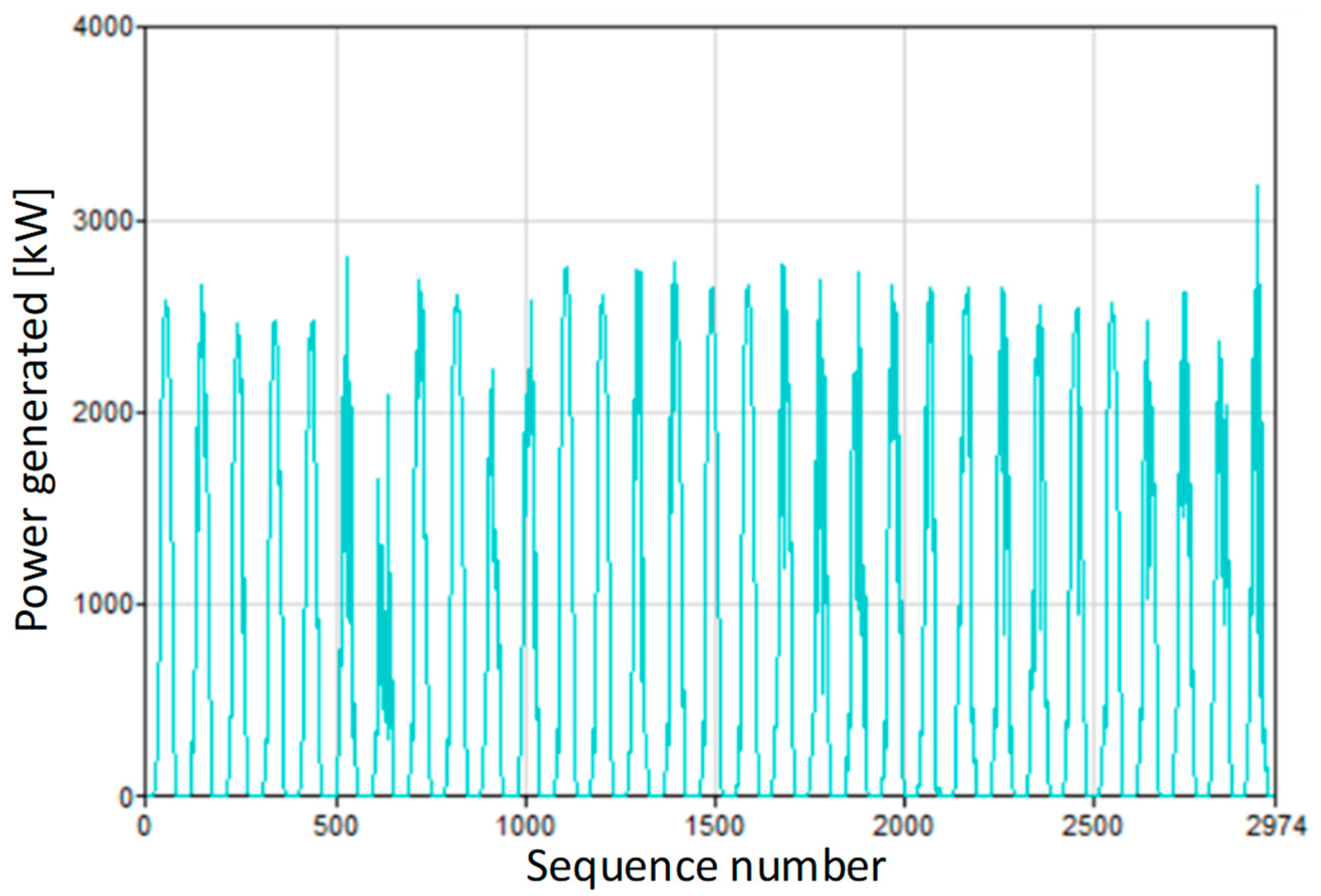




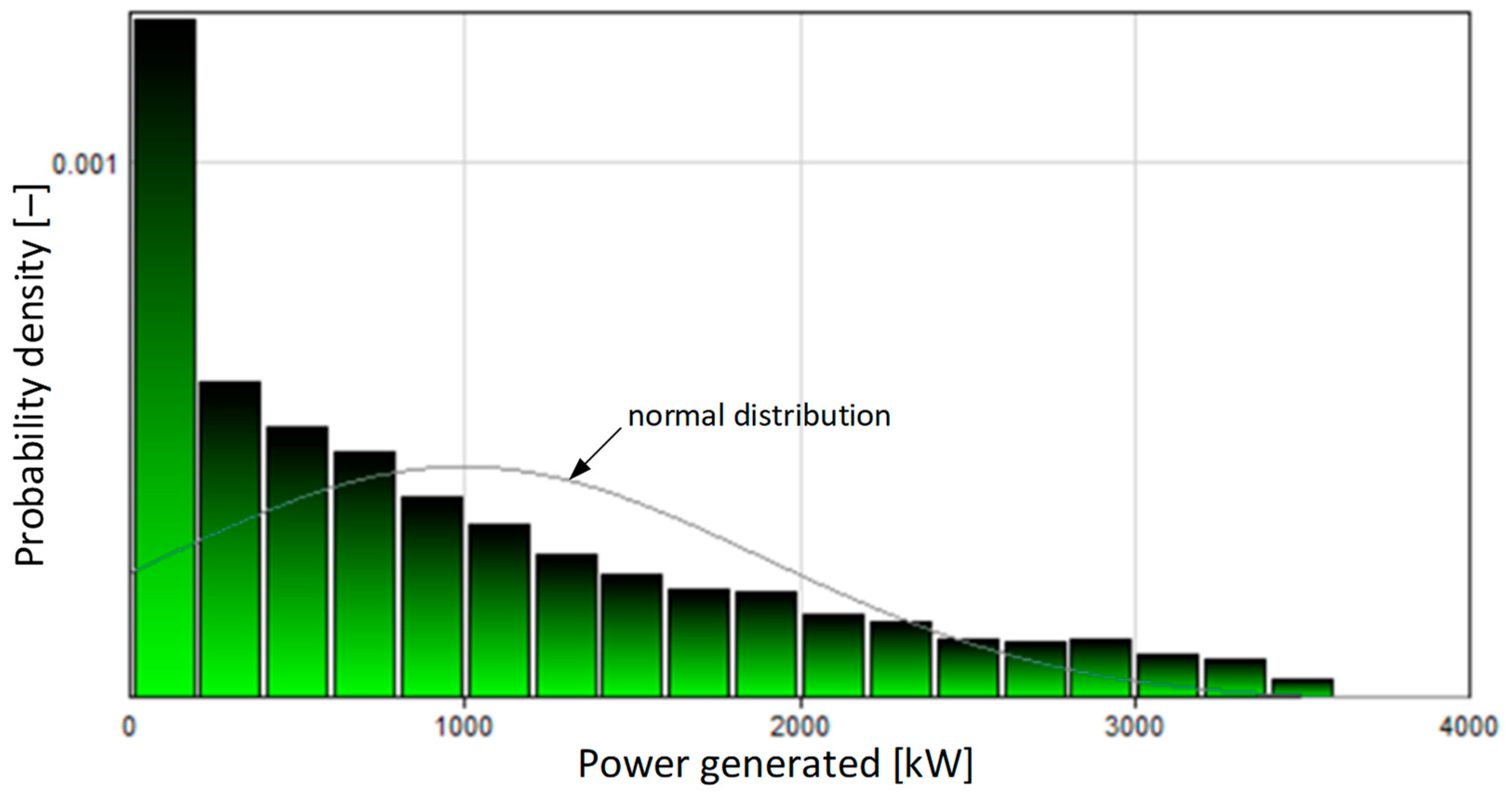
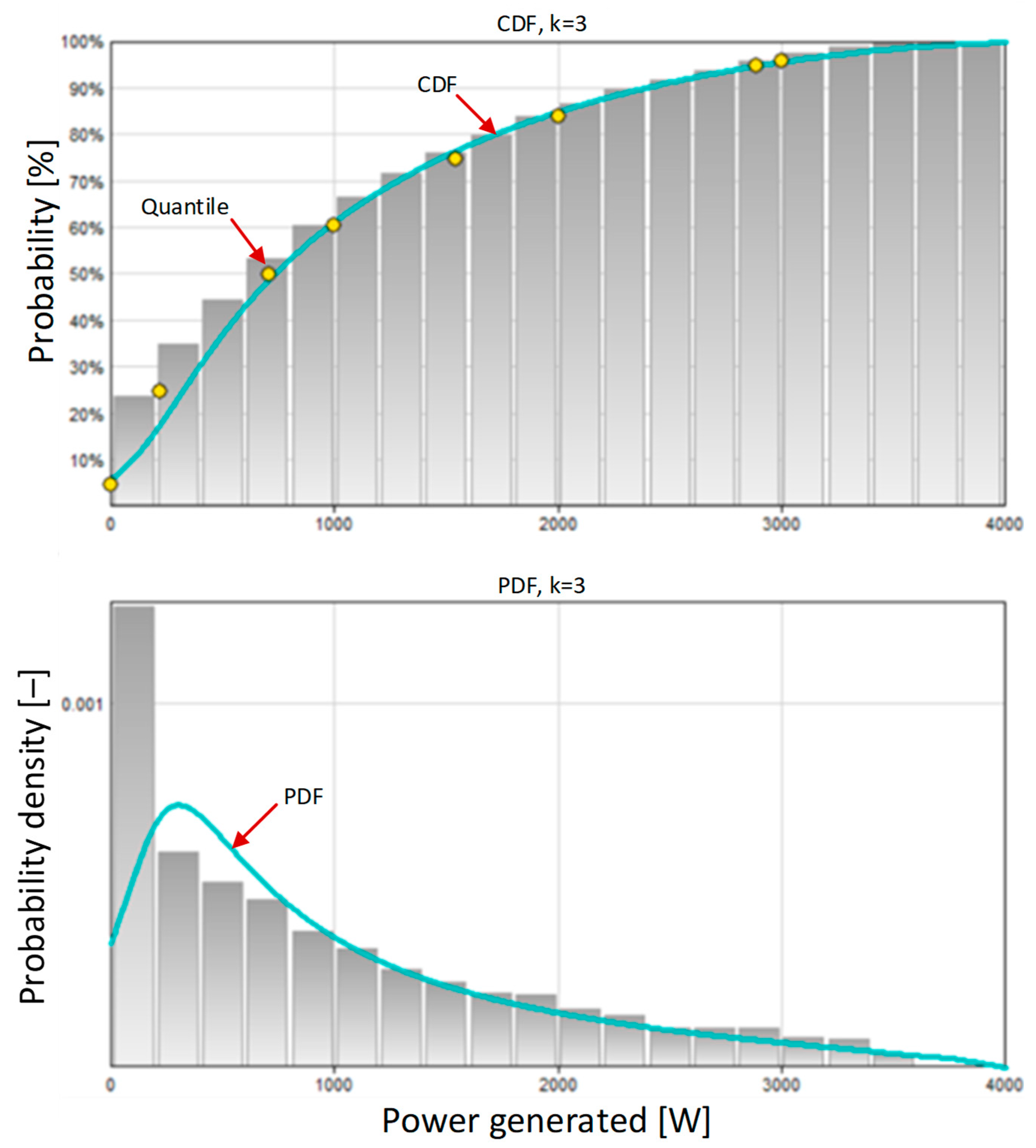
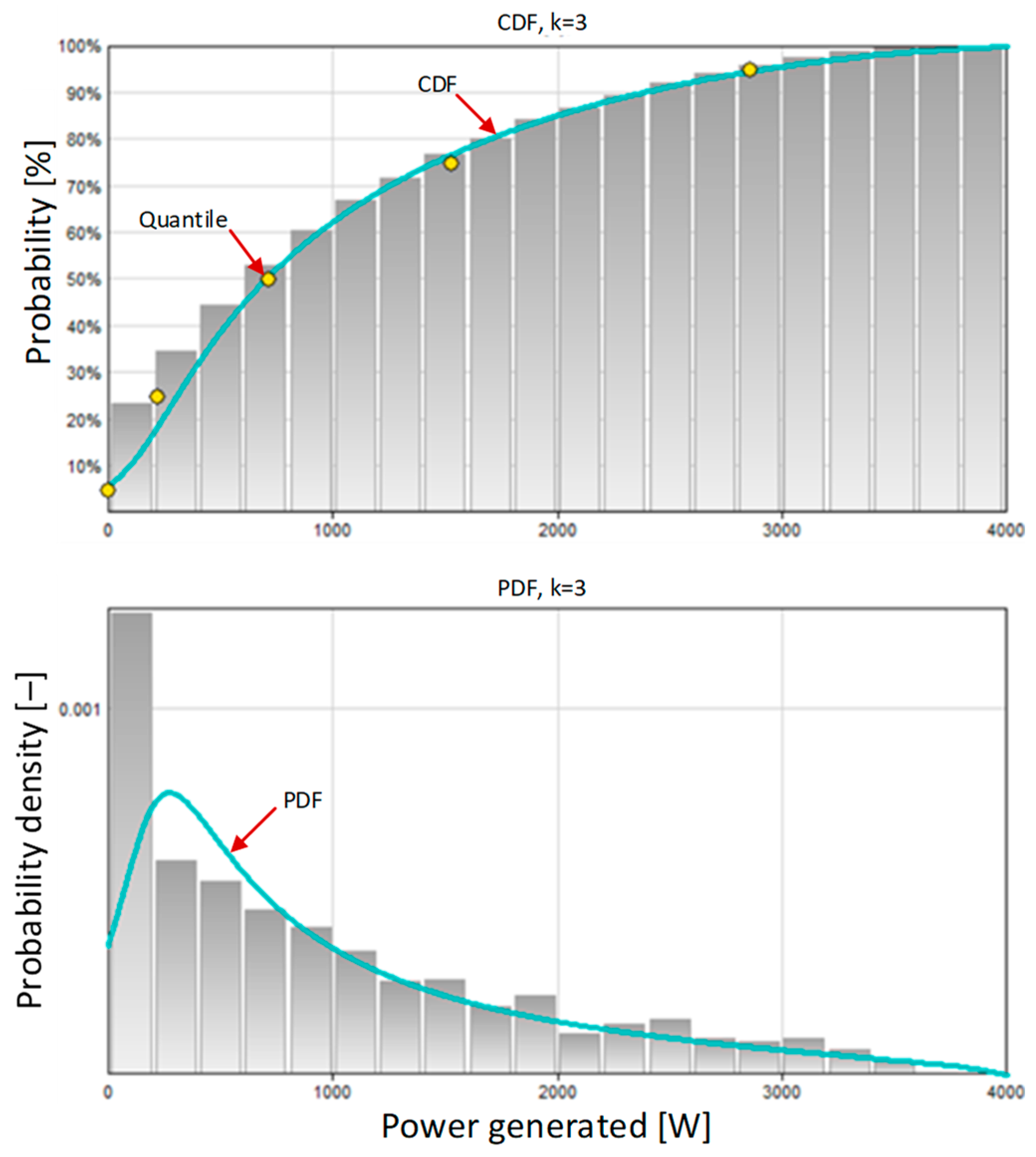


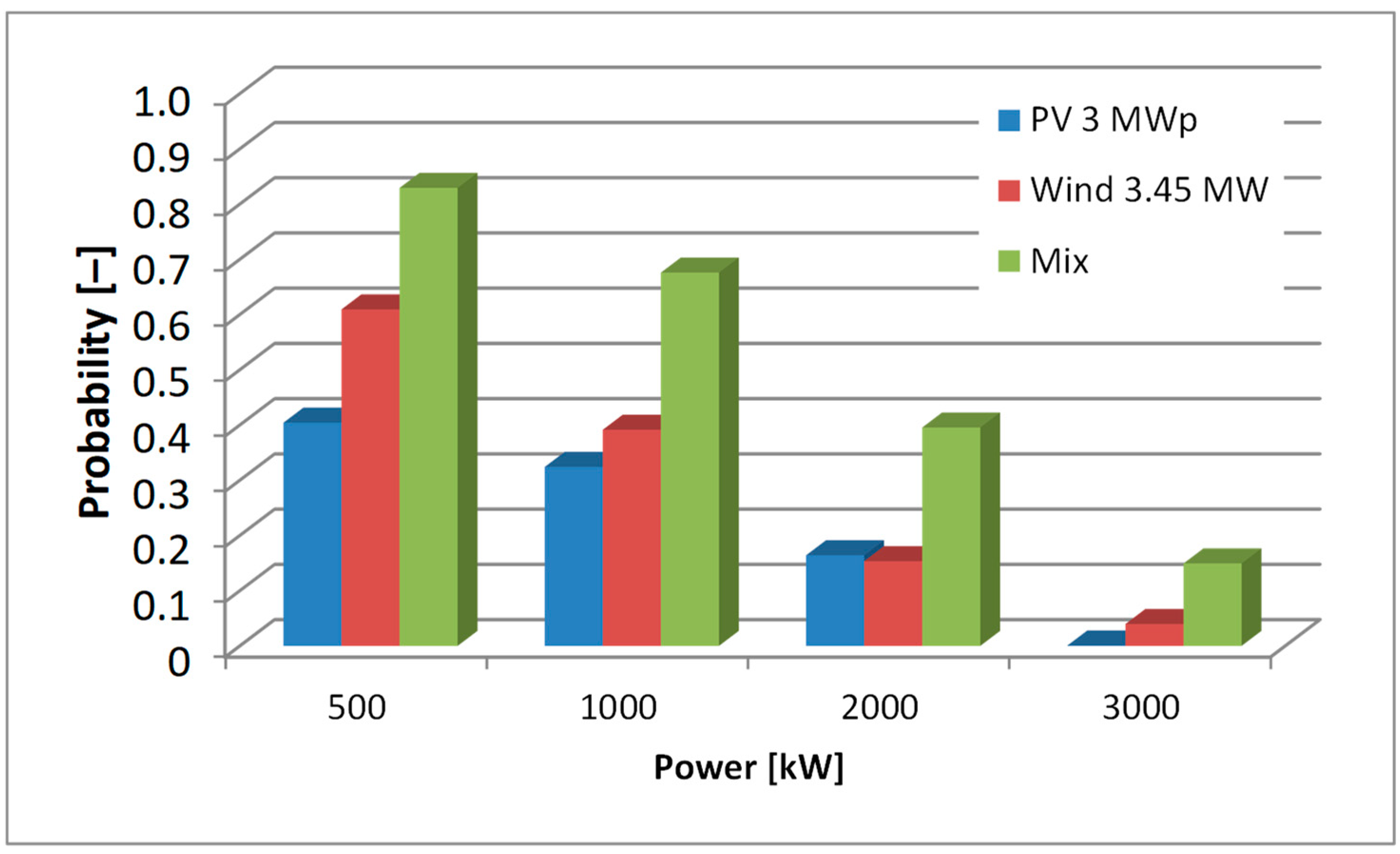

| Power [kW] | |
|---|---|
| Count | 2975 |
| Minimum | 0 |
| Maximum | 3188 |
| Mean | 744.59 |
| StdDev | 915.335 |
| Probability | Power [kW] |
|---|---|
| 0.05 | 0 |
| 0.25 | 0 |
| 0.5 | 228 |
| 0.75 | 1538 |
| 0.95 | 2499 |
| 0.5953 | 500 |
| 0.6703 | 1000 |
| 0.8339 | 2000 |
| 0.9997 | 3000 |
| Power [kW] | Probability ≤ | Probability > |
|---|---|---|
| 500 | 0.5953 | 0.4047 |
| 1000 | 0.6703 | 0.3297 |
| 2000 | 0.8339 | 0.1661 |
| 3000 | 0.9997 | 0.0003 |
| Power [kW] | |
|---|---|
| Count | 1487 |
| Minimum | 0 |
| Maximum | 3188 |
| Mean | 742.843 |
| StdDev | 912.015 |
| Probability | Power [kW] |
|---|---|
| 0.05 | 0 |
| 0.25 | 0 |
| 0.5 | 227 |
| 0.75 | 1544 |
| 0.95 | 2496 |
| 0.5958 | 500 |
| 0.6759 | 1000 |
| 0.8359 | 2000 |
| 0.9993 | 3000 |
| Power [kW] | Probability ≤ | Probability > |
|---|---|---|
| 500 | 0.5958 | 0.4042 |
| 1000 | 0.6759 | 0.3241 |
| 2000 | 0.8359 | 0.1641 |
| 3000 | 0.9993 | 0.0007 |
| Power [kW] | Probability before Interpolation > | Probability after Interpolation > | Relative Error [%] |
|---|---|---|---|
| 500 | 0.4047 | 0.4042 | 0.13 |
| 1000 | 0.3297 | 0.3241 | 1.70 |
| 2000 | 0.1661 | 0.1641 | 1.18 |
| 3000 | 0.0003 | 0.0007 | −100.07 |
| Power [kW] | |
|---|---|
| Count | 4463 |
| Minimum | 0 |
| Maximum | 3450 |
| Mean | 980.951 |
| StdDev | 911.637 |
| Probability | Power [kW] |
|---|---|
| 0.05 | 0 |
| 0.25 | 221 |
| 0.5 | 712 |
| 0.75 | 1542 |
| 0.95 | 2887 |
| 0.3979 | 500 |
| 0.6059 | 1000 |
| 0.8402 | 2000 |
| 0.9617 | 3000 |
| Power [kW] | Probability ≤ | Probability > |
|---|---|---|
| 500 | 0.3979 | 0.6021 |
| 1000 | 0.6059 | 0.3941 |
| 2000 | 0.8402 | 0.1598 |
| 3000 | 0.9617 | 0.0383 |
| Power [kW] | |
|---|---|
| Count | 1487 |
| Minimum | 0 |
| Maximum | 3450 |
| Mean | 978.703 |
| StdDev | 906.256 |
| Probability | Power [kW] |
|---|---|
| 0.05 | 0 |
| 0.25 | 225 |
| 0.5 | 714 |
| 0.75 | 1527 |
| 0.95 | 2862 |
| 0.3907 | 500 |
| 0.6086 | 1000 |
| 0.8467 | 2000 |
| 0.9603 | 3000 |
| Power [kW] | Probability ≤ | Probability > |
|---|---|---|
| 500 | 0.3907 | 0.6093 |
| 1000 | 0.6086 | 0.3914 |
| 2000 | 0.8467 | 0.1533 |
| 3000 | 0.9603 | 0.0397 |
| Power [kW] | Probability before Interpolation > | Probability after Interpolation > | Relative Error [%] |
|---|---|---|---|
| 500 | 0.6021 | 0.6093 | −1.20 |
| 1000 | 0.3941 | 0.3914 | 0.69 |
| 2000 | 0.1598 | 0.1533 | 4.02 |
| 3000 | 0.0383 | 0.0397 | −3.55 |
| Power [kW] | |
|---|---|
| Count | 1487 |
| Minimum | 0 |
| Maximum | 6032 |
| Mean | 1721.55 |
| StdDev | 1142.87 |
| Probability | Power [kW] |
|---|---|
| 0.05 | 101 |
| 0.25 | 749 |
| 0.5 | 1623 |
| 0.75 | 2548 |
| 0.95 | 3651 |
| 0.1708 | 500 |
| 0.3241 | 1000 |
| 0.6046 | 2000 |
| 0.8507 | 3000 |
| Power [kW] | Probability ≤ | Probability > |
|---|---|---|
| 500 | 0.1708 | 0.8292 |
| 1000 | 0.3241 | 0.6759 |
| 2000 | 0.6046 | 0.3954 |
| 3000 | 0.8507 | 0.1493 |
Disclaimer/Publisher’s Note: The statements, opinions and data contained in all publications are solely those of the individual author(s) and contributor(s) and not of MDPI and/or the editor(s). MDPI and/or the editor(s) disclaim responsibility for any injury to people or property resulting from any ideas, methods, instructions or products referred to in the content. |
© 2024 by the authors. Licensee MDPI, Basel, Switzerland. This article is an open access article distributed under the terms and conditions of the Creative Commons Attribution (CC BY) license (https://creativecommons.org/licenses/by/4.0/).
Share and Cite
Dudziak, A.; Małek, A.; Marciniak, A.; Caban, J.; Seńko, J. Probabilistic Analysis of Green Hydrogen Production from a Mix of Solar and Wind Energy. Energies 2024, 17, 4387. https://doi.org/10.3390/en17174387
Dudziak A, Małek A, Marciniak A, Caban J, Seńko J. Probabilistic Analysis of Green Hydrogen Production from a Mix of Solar and Wind Energy. Energies. 2024; 17(17):4387. https://doi.org/10.3390/en17174387
Chicago/Turabian StyleDudziak, Agnieszka, Arkadiusz Małek, Andrzej Marciniak, Jacek Caban, and Jarosław Seńko. 2024. "Probabilistic Analysis of Green Hydrogen Production from a Mix of Solar and Wind Energy" Energies 17, no. 17: 4387. https://doi.org/10.3390/en17174387
APA StyleDudziak, A., Małek, A., Marciniak, A., Caban, J., & Seńko, J. (2024). Probabilistic Analysis of Green Hydrogen Production from a Mix of Solar and Wind Energy. Energies, 17(17), 4387. https://doi.org/10.3390/en17174387








